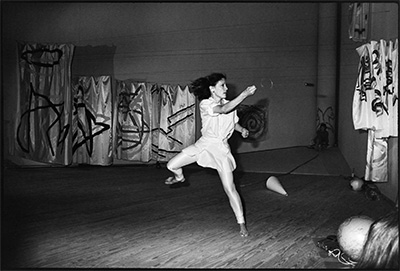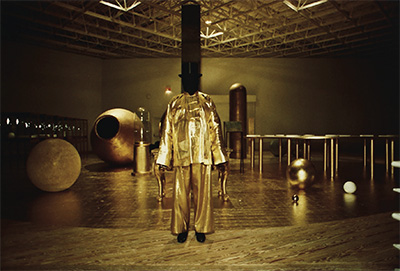“It is not an acropolis we want there. It is not Culture on a corner. I think of the new museum building as a stage environment to house the multimedia in which artists of today are working.” Sebastian J. Adler uttered these words in 1969, referring to the building that would soon house the Contemporary Arts Museum Houston (CAMH). This year, as the museum celebrates its 70th anniversary, they still ring true. It has become known for its continual presentation of fresh works, giving artists space for their first museum shows and constantly struggling to shift perspectives on what art is and can be.

Organized by Exhibitions Manager and Assistant Curator Patricia Restrepo, Stage Environment: You Didn’t Have to Be There, on view Sept. 8 through Oct. 23, is an upcoming exhibition that attempts to showcase the stunning and often understated history of the museum. The exhibition draws its title from the Adler quote stated above and will house documentation and ephemera from performances throughout CAMH’s history, starting with early events hosted at the Museum of Fine Arts, Houston and other locations. Visitors can expect a plethora of documentation and archival materials, ranging from video to letters to press clippings to art objects that cover over 30 performative works presented or supported by the museum.
“One of the goals of this exhibition is to demonstrate that these archival or ephemeral materials do not have to play second fiddle to the live performance that took place, hence the subtitle of the exhibition: You Didn’t Have to Be There,” Restrepo said. “While honoring the power of liveness, this exhibition also showcases the power these ephemeral works can have, thereby inverting the notion that archives are staid and dusty places.”
You Didn’t Have to Be There is a simple yet provocative statement when it comes to performance. Documentation and ephemera certainly play their roles in capturing the aesthetic and residue of actions, but many would argue that as performances are captured, reoriented, and written about, the narrative begins to shift. When you go to a live performance, you experience the artist’s intent, what they want to show you; whether it comes through is a different story. When you look at photographs or watch a recording of it, you experience it through the eye of the photographer, the lens of their camera. When an exhibition presents ephemera, it is the institution’s duty to provide the context, and visitors experience the work through the mindset of the institution.
These moments of presentation have their space in the art world. It’s impossible to experience every performance live, but we can try through these forms of documentation. This is something that Restrepo considered when organizing the exhibition, acknowledging the debate of archive vs. live.
“Stage Environment explores the dialectical relationships between a performance and its documentation,” says Restrepo. “Why is some ephemera labeled artwork, while other performance documents are relegated to archival objects? Entering a decades-long academic debate about these relationships, this exhibition contends that performance documentation and ephemera can have generative and productive functions, not merely serving as consolation prizes for not having been there.”

When presenting an archive show or an exhibition about documentation, museums and art spaces are tasked with the duty of providing context for content without placing the burden of understanding on their visitors. The proper presentation of these materials is a struggle: trying to present a book or essay in a condensed, more accessible format. There are those who would argue that a book is a better means of presenting these works. We tend to understand that books require reading but don’t always expect it when we visit art museums without prior research. Books, though, are passive. We seek them out of our own accord. Exhibitions, on the other hand, are invitations.
“When CAMH was founded in 1948, it was a volunteer run and organized institution that staged exhibitions inside the Museum of Fine Arts Houston (MFAH). Starting with the hiring of Dr. Jermayne MacAgy in 1955, CAMH began to move towards a more professional model,” Restrepo answered when asked about the Adler quote. “CAMH has also been housed in structures downtown and in the medical district before finding its current home catty-corner from the MFAH. Despite these physical address changes, we continue the legacy of an institution that has been a pioneering and revolutionary force for contemporary art, not just locally but also on a much more expansive scale. CAMH’s commitment to presenting cutting edge art of its time has remained steadfast.”
In that last sentence, Restrepo raises another point for the importance of both documentation and this style of exhibition, delving into institutional history. At the time of their presentation, works don’t always seem “cutting edge.” If you’re watching, you can see the shift and impact that presentation has on an artist’s career, but it’s hard to say where it lands in the long-term trajectory of the art world and its history yet unwritten. Archives, documentation, and ephemera house evidence for the paths that artists, spaces, and cities follow. Histories, although not free of institutional influence, become more traceable. From there, with wider context, we can see just how cutting edge we have been.
—MICHAEL McFADDEN

